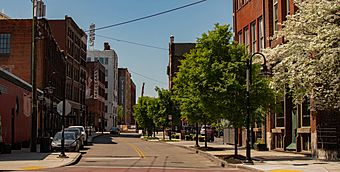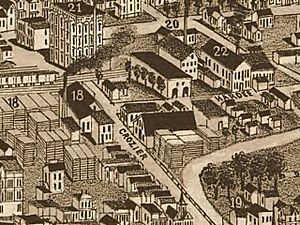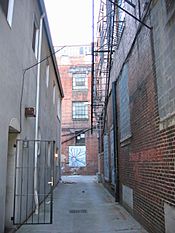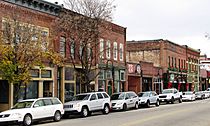Old City, Knoxville facts for kids
Quick facts for kids |
|
|
Southern Terminal and Warehouse Historic District
|
|

East Jackson Ave, in the Old City neighborhood
|
|
| Location | Parts of Jackson Avenue, North and South Central Street, Gay Street, State Street, Vine Avenue and Depot Avenue Knoxville, Tennessee |
|---|---|
| Area | approximately 33 acres (13 ha) |
| Built | 1870–1935 |
| Architect | Frank Pierce Milburn; Et al. |
| Architectural style | Chicago, Classical Revival, Romanesque Revival, Renaissance Revival, Italianate, Vernacular Commercial |
| NRHP reference No. | 85002909 |
| Added to NRHP | November 18, 1985 |
The Old City is a cool neighborhood in Knoxville, Tennessee. You can find it in the northeast part of the city's downtown area. This area was once a busy and sometimes rough part of town. But thanks to lots of hard work since the 1980s, it has become a vibrant and unique place.
Today, the Old City is known for its interesting restaurants, fun bars, clubs, and unique shops. Even though it's called the "Old City," it's not actually the oldest part of Knoxville. Most of this neighborhood became part of the city in the 1850s. This happened when the railroad arrived, bringing new growth and people to the area.
The railroad also brought many Irish immigrants. They helped build the first shops and places to gather in the Old City. After the Civil War, Knoxville grew into a major trading hub in the Southeast. Large warehouses were built, especially along Jackson Avenue. Here, merchants from rural East Tennessee would come to buy goods for their stores.
Starting in 1986, big efforts helped bring the neighborhood back to life. An architect named Peter Calandruccio and a builder named Benny Curl led these changes. Their plans encouraged other developers to start working on properties too. This showed that the Old City had a bright future.
Contents
Where is the Old City?
The Old City is mainly found around where Central Street and Jackson Avenue meet. It's right next to the Southern Terminal train tracks and railyard. These tracks are now part of the Norfolk Southern system.
The neighborhood has some general borders. To the north, it's near Magnolia Avenue. To the west, it's close to Gay Street. Summit Hill Drive is to the south, and interstate overpasses are to the east. Interstate 40 runs just north of the Old City. You can get to it from the Downtown Loop off Summit Hill Drive.
A Look Back in Time
The 1800s: Railroads and Growth
In the early 1800s, Knoxville didn't expand much to the north. By 1852, Vine Avenue was the city's northern edge. But things changed quickly with the creation of Market Square in 1854. The arrival of the railroad in 1855 also sparked a lot of development. By the end of 1855, the city limits had moved north to what is now Emory Place.
The railroad had a huge effect on the city's culture. Hundreds of Irish immigrants came to help build the tracks and train facilities. Many of these immigrants settled in what is now the Old City. Because of this, the area was even called "Irish Town" for a while.
After the Civil War, Irish business owners started building shops and gathering places along Central Street. This street was originally called Crozier Street. These businesses served the people traveling by train. One famous business was a gathering place built by Patrick Sullivan. It started in a wooden building. Later, Sullivan built the fancy brick building that you can still see today at the corner of Central and Jackson.
In 1869, Knoxville's two main train lines joined together. They formed the East Tennessee, Virginia and Georgia Railroad. Over the next few years, this railroad built or bought over 2,500 miles (4,000 km) of tracks across the Southeast. This led to a big boom in factories and wholesale businesses in Knoxville. By 1886, many factories had moved into the Old City. The Burr and Terry Sash Factory was at the corner of Central and Jackson. The four-story City Mills (later White Lily) plant and the Beach's Marble Works were along Depot Avenue. The Elridge Carriage Factory was near the modern corner of Central and Summit Hill.
The Early 1900s: A Diverse Area
By the early 1900s, Central Street had become a very lively area. It was known as "The Bowery," possibly like a similar neighborhood in New York. While it was a busy place, it was also one of Knoxville's most diverse areas. It was one of the few places where businesses owned by Black people operated right next to businesses owned by white people.
Some Black-owned businesses in the neighborhood included the Gem Theater, the Dogan-Gaither Motel, Gleaner Printing Company, and Easley's Grocery. In the early 1900s, a Greek immigrant named Constantine Stergiokis opened one of Knoxville's first Greek restaurants on Central Street. Later, an Italian-American family, the Armettas, opened an ice cream shop in the old Sullivan building.
How the Old City Changed
In the 1970s, a developer named Kristopher Kendrick started buying buildings in the Old City. In an interview, Kendrick shared how the neighborhood got its new name. He was talking to a Coca-Cola bottler named Patrick Roddy. Kendrick said, "I told him that we had bought property down there, and he said, 'Kris, that's the old city,' and I said, 'Pat, that's the perfect name.'"
By the late 1980s, many new businesses had opened in the Old City. These included Annie's, Old City Mercantile, Kerby's Antiques, and Hewgley's Music. Sullivan's Saloon "reopened" as Patrick Sullivan's Steakhouse and Saloon on St. Patrick's Day in 1988. This showed the start of the area's big comeback.
Life in the Old City Today
The White Lily Foods plant, which had been open since 1885, closed in 2008. JFG Coffee was also in the Old City for many years but moved in 2007. The old JFG roasting building at 200 West Jackson Avenue was turned into JFG Flats, which are residential apartments, in 2009. The White Lily Foods building was bought in 2012 by the same company. It reopened as rental apartments in 2015.
John H. Daniel Company, a custom tailoring business, operated on West Jackson from 1928 to 2016. They then moved north of downtown. Their old building was sold to developers and changed into rental loft apartments with shops on the first floor. It's now called "The Daniel" and opened to renters in late 2016.
There are many loft apartments in the older buildings of the Old City. Many of them are located above or behind offices and stores. The Jackson Ateliers Building and Hewgley Park lofts have been homes for many years. More recently, the Jacksonian Condos, JFG Flats, and Fire Street Lofts have been turned into fancy condominiums. Some of these can cost over $600,000.
The Old City often attracts young adults, especially those connected to the University of Tennessee. The university is less than two miles away. The Old City is a great place to live for many young adults because it's close to lots of entertainment and nightlife.








